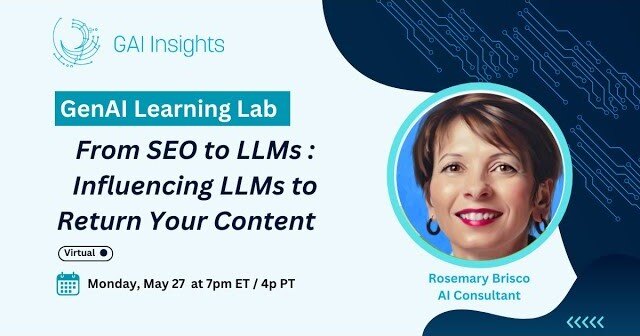SEO and LLMs: AI for the Web and Search Rankings
In a recent talk, Rosemary Brisco, a marketer with 30 years of experience, introduces a discussion on the evolving impact of large language...
 Some just think of AI as ‘the next big thing.’ In starker terms, though, Generative AI (GenAI) is often painted as a metaphorical tornado that can sweep through industry, and dismantle acquired wisdom or legacy business models in an instant.
Some just think of AI as ‘the next big thing.’ In starker terms, though, Generative AI (GenAI) is often painted as a metaphorical tornado that can sweep through industry, and dismantle acquired wisdom or legacy business models in an instant.
But Harvard Business School Professor Shikhar Ghosh has a more complex comparison: GenAI systems, instead of being like tornadoes (impacting immediate reality), are like termites — slowly and stealthily eating away at the foundation.
Analogies like this one teach us how businesses should think about the slow but creeping takeover of GenAI in their operations, and engage through effective AI strategies, and GenAI solutions, that grasp this reality for what it really is.
The Tornado Myth vs. The Termite Reality
The tornado myth preaches that a good AI strategy will lead to abrupt, apocalyptic disruptions — killing off entire industries and job classes at a stroke.
While this perspective may be a little dramatic, it is not uncommon. By contrast, the termite theory that is presented by Professor Ghosh seems to create a scenario of slow and marginal evolution. As a result, GenAI will not immediately destroy, but instead, will erode existing business models over time. As Ghosh puts it, “What you are going to hear is not the destruction of whole categories of work or categories of economic activity. Instead, you are going to see a gradual weakening of the business models.”
Gradual Disruption: How It Works
So often, what we see when we look at AI is that the trend is incremental: business changes over time, in small but significant ways. First, part of a workflow was automated, then job changes happened, etc.
This suggests that the effects of GenAI were not instant, and rather cumulative over time, in deteriorating incumbent business models. And this emphasizes the fact that AI Business Transformation & AI Implementation strategies should be things that firms are considering long-term. The above idea helps, also, in explaining how these sorts of things work.
Case Studies - Termite-like Erosion across the Industry
Here are some industry-specific examples:
Media and Entertainment
AI-enabled content creation tools are slowly taking over the traditional roles in media and entertainment businesses. Small media firms actually took advantage of that – by adopting AI to do what tends to be repetitive, leaving human creatives doing the more creative work they were designed for (and hence helping them create content in shorter times, but still deliver with quality) This kind of solution from GenAI just formalizes how the industry is changing.
Education
The education sector is experiencing a slow but steady shift toward AI-enhanced learning platforms. These platforms are gradually changing the way education is delivered, offering personalized learning experiences that are difficult for traditional models to match. This shift represents a key GenAI Insight into how industries might evolve in the face of AI.
Conclusion
Generative AI's impact on industries is better understood through the metaphor of termites rather than tornadoes. This perspective highlights the importance of gradual adaptation, urging businesses to continuously monitor and evolve their strategies in response to the incremental changes brought about by GenAI. By doing so, they can stay ahead in a landscape that is slowly but steadily being transformed by this powerful technology.
FAQ:
1. Is AI Progress Likely to Be Fast or Slow?
AI progress is expected to be both fast and slow, depending on the context. Technological advancements in AI, such as improvements in algorithms, computing power, and data availability, are progressing rapidly. This fast-paced development leads to frequent innovations and new applications. However, the widespread adoption and integration of AI into existing business models and industries can be slower. This gradual process is often due to factors like the need for infrastructure changes, regulatory considerations, and the time required for businesses to adapt and fully leverage AI’s potential.
2. What Can Businesses Do to Adapt?
Businesses can adapt to AI by taking a proactive and strategic approach. That might include investing in education, focusing on core data, collaboration with partners and stakeholders, and quick business process evolution.
3. What Do Current GenAI Solutions Most Often Look Like?
Current Generative AI (GenAI) solutions typically manifest as tools that create content, assist with creative tasks, or generate data-driven insights. These solutions often include items like text generation tools, visuals, chatbots, and data analysis engines.

In a recent talk, Rosemary Brisco, a marketer with 30 years of experience, introduces a discussion on the evolving impact of large language...

Companies are dealing with the fast-moving landscape of Generative AI (GenAI) … when you look at it closely, the question of benchmarking their...
Trusted by companies and vendors around the globe - we help you cut through the noise and stay informed so you can unlock the transformative power of GenAI .
Join us at this year's Generative AI World! Hear from enterprise AI leaders who are achieving meaningful ROI with their GenAI initiatives and connect in-person with the GAI Insights members community including C-suite executives, enterprise AI leaders, investors, and startup founders around the world